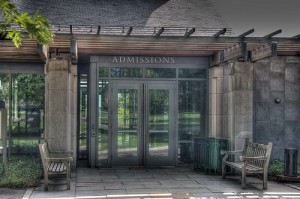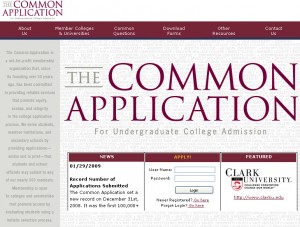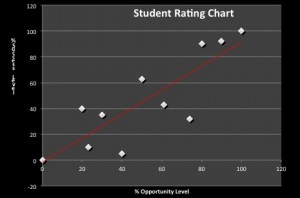The admissions process is complicated and extraneous to all students. The difficult decision of choosing where to spend the next four invaluable years of school is based solely on the way people can display themselves. Criterion such as grades, standardized test scores and community service all have an impact on the decision process when looking at applications. However, many colleges and universities place a heavy amount of the decision on the conditions that many cannot control. Factors like financial status, alumni connection and racial background play a vital role in who is accepted and who is denied. As we have seen in readings and simulations in class, it is often those with advantages in these areas that are accepted over the real qualified students. Trinity College should revise its application process to enhance the consistency of applicants by evaluating students on their future potential rather than assessing them on their past. Privileged individuals do have an advantage in the admissions process. This system should be set in place to both minimize the influence that these privileges have in the final decision and evaluate the students based on their success given certain advantages. Although it may seem impossible to make a perfect system to determine who is accepted and who isn’t, there should be revisions to the current process to provide more consistency. The qualifications of an applicant should be evaluated in terms of the factors that can be controlled by students; factors that compare the success of students up until college based upon both their educational and socioeconomic background.
Similar to most colleges and universities, Trinity College searches through thousands of applications to find the most qualified and well-rounded students. To make the difficult task of determining which students should be chosen from the thousands that apply, Trinity depends on many sources of information to “try to balance the following factors when evaluating candidates for admission” (Trinity College). Trinity College states that it takes into consideration factors such as 1.) Your transcript 2.) Course selection 3.) The quality of your course loads and prefers to see that you have challenged yourself with the strongest program that you can handle 4.) Standardized test scores 5.) One (1) college or guidance counselor recommendation, as well as two (2) teacher recommendations 6.) Grades and 7.) Extracurricular activities etc (Trinity College). Despite the information given, it is unpractical for a college to look at just these factors alone, for there are other attributes that should be acknowledged. Yet, it is important to pay attention to the influence certain factors play in determining who gets admitted and what additional attributes should be viewed to make such a decision.

In discussions over the current admissions process, one controversial issue has been the validity in the admissions structure. On the one hand, some argue that the current application process provides the best indication of a student’s full potential in college. Others maintain that the current process is flawed. The general argument made by Bryan Nance in his work For a Fairer Admissions Process, Read Between the Lines, is that the current admissions process is unsound because of the indicators it uses to determine the best applicants. More specifically he argues that the system is flawed because of the heavy amount of weight placed upon the quantitative information received by schools. He states, “Although these are extremely important [grades and standardized test scores], the historic numbers-trump-all model has become increasingly outdated in its ability to assess an applicant’s true potential, especially among low-income, first-generation, and minority students”(Nance). Here, Nance suggests that the current system is inaccurate because of its inability to properly determine the future success of students. Furthermore, he mentions that, colleges and universities that use this system find more difficulties in evaluating the future potential of students that fall in the racial or economical minority. Today’s system is structured to favor the wealthier white majority that applies to higher education schools such as Trinity. Numerical evaluators will generally be higher within communities with more superior school systems and resources. Systematic changes must be made to discontinue the unequal “playing field” for applicants coming from advantageous backgrounds.
Instead of referring to standardized tests scores and high school GPA’s, the college admissions team should look at more effective indicators of a student’s potential. Teacher recommendations and the decisions for students to choose harder level courses in high school should be looked at more closely. The choice to challenge oneself portrays the work ethic needed to succeed both in college and afterwards. Connections between Trinity and all high schools should be strengthened to help build relationships between the admissions staff and the teachers of those schools. The recommendations are one of the few times in an application where students get use the opinions of other adults to describe the real identity of an applicant. These are just a few of the indicators that should be looked at more closely, over the heavily weighted numerical indicators.

Some may say that the college admissions decision is based on all contributing factors to an application. Although this may be true to a certain extent, the most important factors in an application are based on aspects that the applicant cannot control. Factors such as social status, race, legacy and early decision advantages play a huge determining role in the final decision. Applying early decision or early action to a college is a huge advantage for the student coming from a higher economic background. However, this advantage is not practical for all applicants given their financial status. In the article, The Troubling Rise in Early Admissions, Richard Kahlenberg discusses why and for whom the early decision process helps and in some cases hurts students in the admission process. Kahlenberg states, “Early decision programs are particularly unfair to low-income applicants because the binding commitment to attend a particular college eliminates the ability to bargain between colleges for the most advantageous financial aid packages” (Kahlenberg). In this statement he explains how the admissions process is unfair to students of lower socioeconomic status, while wealthier students have it easier because of early decision possibility.
At Trinity itself, the admissions staff takes into consideration these attributes when deciding who to admit and who to deny. These problems are not only here at Trinity but are occurring nationwide. At Texas A&M, the admissions staff was experiencing some of the same problems. Yet, they have made improvements by choosing to abolish the admission of legacies that have fewer qualifications in comparison to non-legacy students (Schmidt). Furthermore, factors that have to do with connections and background should be weighed less. A student’s admittance should be based on their own performance in and out of school.
The admissions process at Trinity College needs to recognize the success of students in relation to the background they come from, rather than in comparison to all the applicants in the admissions pool. Many would agree there exists a major gap between the types of educations amongst various communities. Wealthier and more affluent communities tend to yield students with greater résumés while impoverished neighborhood struggle to send a higher percentage of students to school after high school. In Derek Bok’s article Closing the Nagging Gap in Minority Achievement, he acknowledges that the problem is, “closing the gap in academic achievement and standardized test scores separating black students from their white and Asian-American counterparts. The gap is nationwide, it is substantial, and it has not diminished in the last 15 years. The task is all the more difficult because most experts attribute the gap to racial differences in child-rearing, preschool preparation, and opportunities for a quality public-school education” (Bok). Here, there is a recognized disparity between students who are raised in drastically different environments that often goes unaccounted for in the admissions process. Students are undoubtedly tested to overcome greater disadvantages when not given the proper resources to succeed like their wealthier counterparts. To level the playing field, students at Trinity College need to be evaluated based on the success of where they come from rather than in comparison to the group as a whole.
The success of students should be judged in comparison to the background in which they come from. The graph above is a model intending to display the new way the admissions staff at Trinity should view its applicants. The linear line (shown in red) is the space on the graph that predicts the average success that a student should have, given a certain opportunity level. The opportunity level is displayed using numbers from zero to one hundred (one hundred symbolizing a background with more opportunities). A higher opportunity level is computed by looking at the resources and guidance that students had throughout middle school and high school. Students that fall below the line are students that did not succeed to the potential the college would expect given the background from where they came from. On the contrary, students that lie above the line are indicators of applicants that surpassed the expected level of success prior to coming to Trinity College. It is important to emphasize the difference of a student surpassing expectations given a lower opportunity level in comparison to a student coming from a wealthier background. Trinity College should look at factors such as these to gain more understanding on the personality and character of each individual.
Our solutions to these problems are meant to fix the current inconsistencies in the admissions process at Trinity. With these solutions, come possible dilemmas such as funding and disagreement in the new evaluation system. However, the goal of these revisions is to create a new way to properly evaluate students in an equal way; to judge students on their capabilities of becoming successful in the future both at college and afterwards. Like any changes in a process, this process may take awhile to ever fully be effective. Yet, with time there can be a new and more efficient way to evaluate the leaders of tomorrow.
About the authors: James DiBlasi and Casey Tanner are two first-year students in the Color and Money Seminar. Both students come from the greater Boston area; James (Winchester, Ma) and Casey (Wellesley, Ma).
Bibliography
Admissions Staff. “FAQ.” Trinity College. Trinity College, 2011. Web. 2011.
Anne West, Hazel Pennell, and Philip Noden, “School Admissions: Increasing Equity, Accountability and Transparency,” British Journal of Educational Studies 46, no. 2 (June 1, 1998): 188-200.
Bartlett ,Tom, “Race Is a Factor in Admissions at a Third of Colleges, Survey Finds,” The Chronicle of Higher Education, October 10, 2003, Volume 50, Issue 7 edition, sec. Students.
Bok, Derek, “Closing the Nagging Gap in Minority Achievement,” The Chronicle of Higher Education, October 24, 2003, Volume 50, Issue 9 edition, sec. The Chronicle Review.
“Fall Timeline for High School Seniors: November « College Blog by Kris Hintz.” College Blog by Kris Hintz. Web. 05 Dec. 2011.
Fischer, Karin, “Unknown Factor Hampers Minority Students’ Performance in College, Study Finds,” The Chronicle of Higher Education, June 6, 2003, Volume 49, Issue 39 edition, sec. Students.
Kahlenberg, Richard. “The Troubling Rise in Early Admissions,” The Chronicle of Higher Education, Innovations, October 29, 2010, http://chronicle.com/blogs/innovations/the-troubling-rise-in-early-admissions/27737.
Nance, Bryan G. “For a Fairer Admissions Process, Read Between the Lines,” The Chronicle of Higher Education, September 19, 2010, sec. Diversity in Academe, http://chronicle.com/article/For-a-Fairer-Admissions/124444/
Sawallich, Christopher. Trinity College Chapel Hartford, CT AdmissionsBuilding, October 14 2011, http://www.flickr.com/photos/csawallich/6244617023/.<.
Schmidt, Peter, “New Pressure Put on Colleges to End Legacies in Admissions,” The Chronicle of Higher Education, January 30, 2004, Volume 50, Issue 21 edition, sec. Archives : Government & Politics.
